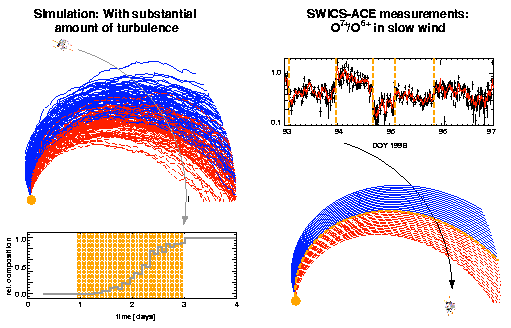

The charge-state ratio O7+/O6+ in the solar wind is determined close to the Sun and remains unchanged during the expansion of the wind and detection by SWICS/ACE. Because solar wind ions remain attached to the magnetic field, they make it possible to follow the turbulent evolution of these field-lines from close to the Sun to 1 AU. This turbulent evolution should be best seen in the slow solar wind, since: (1) slow solar wind exhibits very well developed magnetic turbulence and (2) slow solar wind also shows larger variations in composition than, for example, fast solar wind streams. If there is no turbulent motion of field-lines in the inner heliosphere, compositional variations will be conserved out to 1 AU and very steep transitions between streams of differing composition will be observed. If, however, there is significant turbulence, magnetic field-lines will diffuse in space (as indicated in the upper left of the Figure) and an initially steep transition will be smeared. Direct effects of the turbulent motion could then be inferred by comparison with simulations such as that shown in the lower left.
We now consider observations from ACE/SWICS during April 3-7, 1998, shown in the upper right. This period, characteristic of many similar periods, exhibits clear structure in O7+/O6+ with very sharp transitions. The solar wind speed is almost constant and typical of slow solar wind. The observation that composition transitions remain virtually unaffected is indicative of very little turbulent motion, as sketched in the lower right. This example constrains models that treat the solar wind as a turbulent medium and also has implications for models of energetic-particle transport on these field-lines. Using very conservative values for the diffusion coefficient along the average magnetic field direction, the perpendicular diffusion due to the turbulence level indicated in the lower right is very small (Kperp/Kparallel < 0.002). Again, this upper limit is much smaller than typically assumed in models for interplanetary particle transport.
It is not obvious how these composition results can be consistent with widely held models for solar wind turbulence and particle transport in the inner heliosphere. It may be that the composition boundaries shown above are indicative of some special surfaces, perhaps tangential discontinuities. The data may also indicate that the turbulent character of the solar wind is very much different than we thought before.
Contributed by Thomas Zurbuchen and Simon Hefti of the University of Michigan.
See The SWICS and SWIMS Home Page for more information about the SWICS instrument.
Last modified 30 November 1998,
Andrew Davis
Return to ACE homepage.
/ACE/